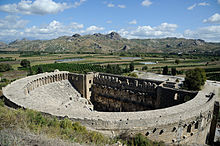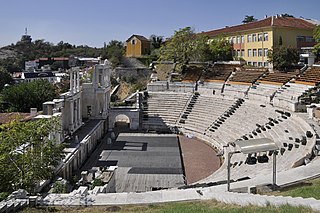
Aspendos or Aspendus was an ancient Greco-Roman city in Antalya province of Turkey. The site is located 40 km east of the modern city of Antalya.
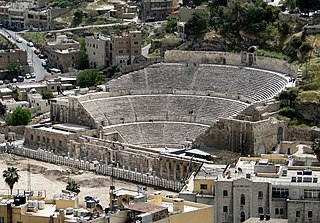
Roman theatres derive from and are part of the overall evolution of earlier Greek theatres. Much of the architectural influence on the Romans came from the Greeks, and theatre structural design was no different from other buildings. However, Roman theatres have specific differences, such as generally being built upon their own foundations instead of earthen works or a hillside and being completely enclosed on all sides.

The Theatre (UK) or Theater (US) of Pompey, also known by other names, was a structure in Ancient Rome built during the latter part of the Roman Republican era by Pompey the Great. Completed in 55 BC, it was the first permanent theatre to be built in Rome. Its ruins are located at Largo di Torre Argentina.

The Theatre of Marcellus is an ancient open-air theatre in Rome, Italy, built in the closing years of the Roman Republic. At the theatre, locals and visitors alike were able to watch performances of drama and song. Today its ancient edifice in the rione of Sant'Angelo, Rome, once again provides one of the city's many popular spectacles or tourist sites.
Tavium, or Tavia, was the chief city of the Galatian tribe of Trocmi, one of the three Celtic tribes which migrated from the Danube Valley to Galatia in present-day central Turkey in the 3rd century BCE. Owing to its position on the high roads of commerce was an important trading post. The site was successively occupied by Hittites, Cimmerians, Persians, Celts, Greeks, Romans, Seljuk Turks and Ottoman Turks. At the time of the Roman Empire, Tavium was an important crossroads and a stopping place on the caravan routes.

Prusias ad Hypium was a city in ancient Bithynia, and afterwards in the late Roman province of Honorias. In the 4th century it became a bishopric that was a suffragan of Claudiopolis in Honoriade. Before its conquest by King Prusias I of Bithynia, it was named Cierus or Kieros and belonged to the Heraclea Pontica. Photius writes that it was called Kieros, after the river which flows by it.

The Eurymedon Bridge was a late Roman bridge over the river Eurymedon, near Aspendos, in Pamphylia in southern Anatolia. The foundations and other stone blocks (spolia) of the Roman structure were used by the Seljuqs to build a replacement bridge in the 13th century, the Köprüpazar Köprüsü, which stands to this day. This bridge is characterized by a significant displacement along its mid-line, noticeable by looking at its ancient piers.

Roman amphitheatres are theatres — large, circular or oval open-air venues with raised seating — built by the ancient Romans. They were used for events such as gladiator combats, venationes and executions. About 230 Roman amphitheatres have been found across the area of the Roman Empire. Early amphitheatres date from the Republican period, though they became more monumental during the Imperial era.

The Roman Theatre of Mérida is a construction promoted by the consul Vipsanius Agrippa in the Roman city of Emerita Augusta, capital of Lusitania. It was constructed in the years 16 to 15 BCE. One of the most famous and visited landmarks in Spain, the Roman Theatre of Mérida is regarded as a Spanish cultural icon and was chosen as one of the 12 Treasures of Spain.

The Theatre of Clunia Sulpicia is a Roman theatre in the ancient city of Colonia Clunia Sulpicia, in what is now province of Burgos, northern Spain. Built on a hill called Alto de Castro, it is located between the modern-day villages of Coruña del Conde and Peñalba de Castro, in the south of the province of Burgos.

The Roman Theatre at Apamea is a Roman theatre in ancient Apamea in northwestern Syria. Originally a Hellenistic theatre, the monumental structure was one of the largest theatres in the Roman world.

The Greek theatre of Syracuse lies on the south slopes of the Temenite hill, overlooking the modern city of Syracuse in southeastern Sicily, Italy. It was first built in the 5th century BC, rebuilt in the 3rd century BC and renovated again in the Roman period. Today, it is a part of the Unesco World Heritage Site of "Syracuse and the Rocky Necropolis of Pantalica".
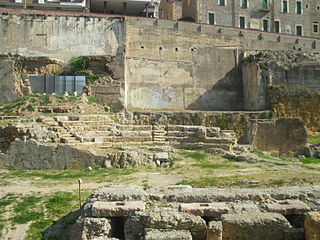
The Roman theatre of Tarraco was a Roman theatre built in Tarraco in the time of Augustus in the area of the local forum and the port, the planners took advantage of the steep slope of the hill to build part of the seating.

The theatre area of Pompeii is located in the southwest region of the city. There are three main buildings that make up this area: the Large Theatre, the Odeon, and the Quadriporticum. These served as an entertainment and meeting centre of the city. Pompeii had two stone theatres of its own nearly two decades before the first permanent stone theatre was erected in Rome in the 50s BC.
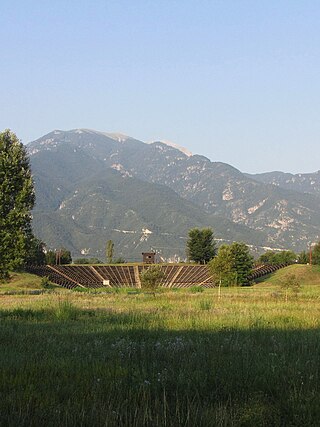
The largest building of the Archaeological Park of Dion in northern Greece is the Hellenistic-era theatre. It is located in the south of the village of Dion, Pieria and is often used during the summer for performances of the Olympus Festival.
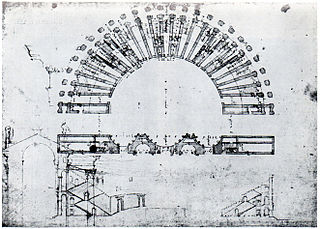
The Teatro Berga was a Roman theatre in Vicetia, modern Vicenza, Italy. It stood in an area beyond the Retrone river, in what is now part of the historic centre of the city. Its site corresponded to buildings currently standing between Contrà Santi Apostoli, Piazzetta San Giuseppe, Contrà Porton del Luzzo, Piazzetta Gualdi, Contrà del Pozzetto and contrà Lioy. Contrà Porton del Luzzo follows the semi-circular route of the external perimeter of the south-facing cavea of the former theatre.
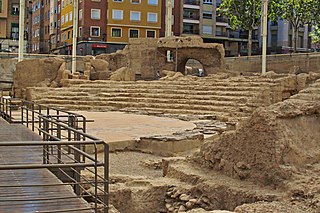
The Roman Theater of Zaragoza is a theater from the Roman era, built in the first half of the 1st century AD, in the Age of Tiberius and Claudius. It had a capacity of 6,000 spectators and followed the model of the Theatre of Marcellus in Rome. It was active until the third century.

The Roman Theatre of Catania consists of the ruins of two open-air semicircular ancient Roman theatres, located between Piazza San Francesco, via Vittorio Emanuele, via Timeo, and via Teatro Greco in the center of Catania, Sicily, southern Italy. The site consists of a larger theatre and a smaller semicircular theatre, an Odeon. The structure is part of the Parco archeologico greco-romano di Catania.
